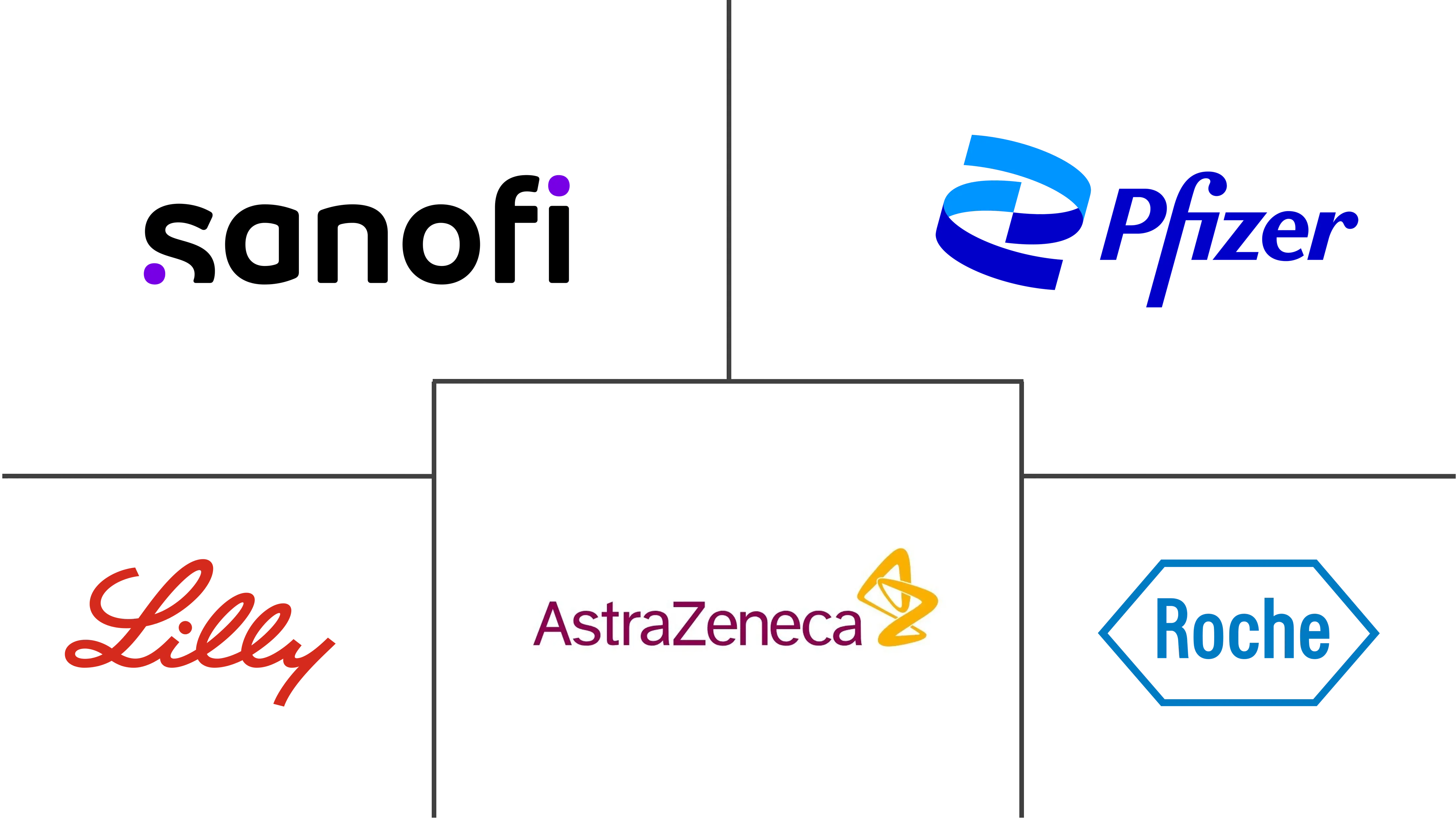Pharmaceutical Manufacturing Market Size and Share
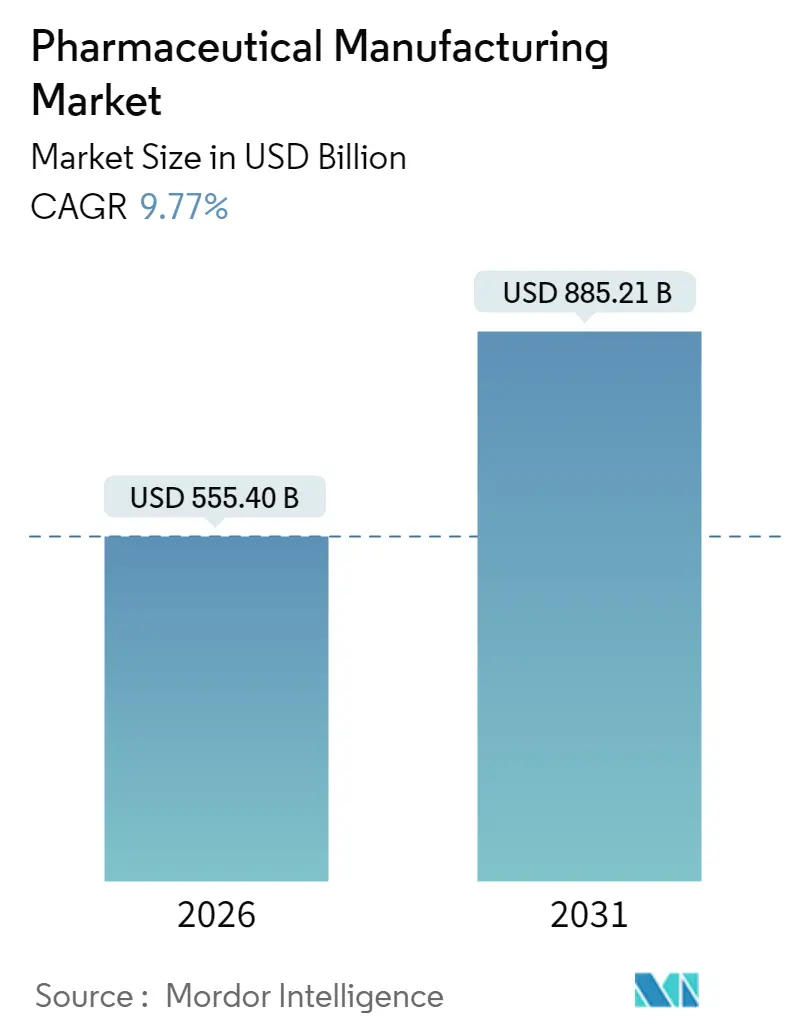
Pharmaceutical Manufacturing Market Analysis by Mordor Intelligence
The Pharmaceutical Manufacturing market is expected to grow from USD 505.97 billion in 2025 to USD 555.4 billion in 2026 and is forecast to reach USD 885.21 billion by 2031 at 9.77% CAGR over 2026-2031.
The pharmaceutical manufacturing market is moving toward advanced technologies, greater biosimilar capacity, and regionally diversified supply chains that collectively help manufacturers satisfy rising global demand and comply with tighter regulations. Momentum is reinforced by continuous-processing economics, reshoring incentives, and artificial-intelligence-enabled quality control systems that shorten time-to-market cycles and support high-mix, low-volume production strategies. CDMOs are scaling rapidly to meet biologics demand, North American companies are pouring capital into domestic capacity, and Asia-Pacific governments are refining regulatory frameworks, all of which position the pharmaceutical manufacturing market for sustained double-digit growth.
Key Report Takeaways
- By manufacturing mode, in-house operations led with 58.79% of pharmaceutical manufacturing market share in 2025, while CDMOs are projected to grow at a 10.69% CAGR to 2031.
- By molecule type, small-molecule drugs held 60.58% revenue share in 2025; biologics and biosimilars are forecast to advance at a 10.22% CAGR.
- By formulation, tablets accounted for 33.05% of the pharmaceutical manufacturing market in 2025, whereas injectables are expanding at an 10.93% CAGR through 2031.
- By manufacturing technology, batch processes retained 74.05% share in 2025; continuous manufacturing is rising at a 12.05% CAGR.
- By application, oncology captured 28.12% share of the pharmaceutical manufacturing market in 2025 and is advancing at a 13.63% CAGR.
- By prescription type, prescription drugs represented 83.05% share in 2025, while OTC medicines are growing at an 11.67% CAGR.
- By geography, North America commanded 37.25% share in 2025; Asia-Pacific is growing fastest at a 12.4% CAGR.
Note: Market size and forecast figures in this report are generated using Mordor Intelligence’s proprietary estimation framework, updated with the latest available data and insights as of January 2026.
Global Pharmaceutical Manufacturing Market Trends and Insights
Drivers Impact Analysis
| Driver | (~) % Impact on CAGR Forecast | Geographic Relevance | Impact Timeline |
|---|---|---|---|
| Rising R&D Investments by Big Pharma | +1.8% | Global, concentrated in North America & Europe | Medium term (2-4 years) |
| Acceleration of Continuous Manufacturing | +1.5% | North America & EU, expanding to APAC | Long term (≥ 4 years) |
| Integration of AI, IoT, and Automation across Legacy Facilities | +1.2% | Global, led by developed markets | Medium term (2-4 years) |
| Biosimilar Surge Following Major Patent Expirations | +2.1% | Global, strongest in North America & Europe | Short term (≤ 2 years) |
| Reshoring and Localization of API Production | +1.0% | North America & Europe primarily | Long term (≥ 4 years) |
| Sustainability and Circular Manufacturing Initiatives | +0.7% | Global, regulatory-driven in EU | Long term (≥ 4 years) |
| Source: Mordor Intelligence | |||
Rising R&D Investments by Big Pharma
Large pharmaceutical companies are channeling unprecedented funds into research, development, and manufacturing upgrades, with global drug spending projected to reach USD 1.9 trillion by 2032. Biologics alone are set to surpass USD 600 billion in annual revenue, prompting firms to align R&D and manufacturing budgets so that facility design directly supports clinical pipelines.[1]Pfizer CentreOne Team, “Biologics Market Outlook 2032,” Pfizer CentreOne, pfizercentreone.com Capital allocations of USD 50 billion or more from Novartis and Roche illustrate how integrated R&D-manufacturing strategies can accelerate radioligand and biologics programs, while AI-enabled process optimization has already boosted throughput by 20% in pilot plants across the pharmaceutical manufacturing market.
Acceleration of Continuous Manufacturing
Continuous-processing adoption cuts facility footprints by 70% and operating costs by up to 50%, providing an immediate economic rationale for transition from batch production within the pharmaceutical manufacturing market. The FDA’s implementation of ICH Q13 gives companies a clear regulatory pathway, leading to faster review times for continuous-manufactured drugs and vaccines.[2]TechTarget Research, “Continuous Manufacturing Cost Reduction,” TechTarget, techtarget.com Approved products from Pfizer and Eli Lilly validate commercial viability, while emerging platforms now cover nanomaterials and lipid-nanoparticle mRNA products.[3]AAPS Researchers, “mRNA Continuous Manufacturing Advances,” AAPS Open, aapsopen.springeropen.com
Integration of AI, IoT, and Automation across Legacy Facilities
Predictive maintenance, digital twins, and automated visual-inspection systems are mitigating downtime and cutting batch-failure rates shaping adoption patterns in the pharmaceutical manufacturing market. Samsung Biologics reports lower variability after deploying computational-fluid-dynamics models to fine-tune bioreactor performance. Despite demonstrable productivity gains of 150-200%, 66% of executives remain dissatisfied with AI integration progress because capital outlays and workforce skill gaps slow rollouts.
Biosimilar Surge Following Major Patent Expirations
Patent cliff dynamics are creating unprecedented market opportunities throughout the pharmaceutical manufacturing market, at risk from 190 drug patent expirations by 2030, including 69 blockbuster medications. Key patent expirations in 2025 include Johnson & Johnson's Stelara, Regeneron's Eylea, and Novartis's Entresto, creating immediate biosimilar manufacturing opportunities. Manufacturing implications include quality-by-design approaches for biosimilar development, with regulatory acceptance requiring demonstrated similarity to innovator drugs through comprehensive analytical characterization.
Restraints Impact Analysis
| Restraint | (~) % Impact on CAGR Forecast | Geographic Relevance | Impact Timeline |
|---|---|---|---|
| Global Drug Pricing Pressures and Cost Containment Policies | -1.4% | Global, strongest in North America & Europe | Short term (≤ 2 years) |
| Supply Chain Disruptions for Critical Inputs | -1.1% | Global, concentrated in import-dependent regions | Short term (≤ 2 years) |
| Regulatory Complexity for Advanced Manufacturing Technologies | -0.8% | Global, varying by jurisdiction | Medium term (2-4 years) |
| Skilled Workforce Shortage in Biotech Manufacturing | -0.9% | Global, acute in developed markets | Long term (≥ 4 years) |
| Source: Mordor Intelligence | |||
Global Drug Pricing Pressures and Cost-Containment Policies
The U.S. Inflation Reduction Act authorizes Medicare negotiations, accelerating a shift toward lower launch prices and higher rebate exposure. On 1 January 2024, regulators recorded 453 brand-price hikes offset by 30 decreases, signaling intense scrutiny that compresses manufacturer margins. European proposals such as the Critical Medicines Act add parallel pressure by incentivizing local production while capping reimbursement, compelling firms to pursue aggressive automation to defend profitability.
Supply-Chain Disruptions for Critical Inputs
Geopolitical tensions and raw-material bottlenecks continue to delay active-pharmaceutical-ingredient (API) deliveries, elevating safety-stock needs and increasing working-capital requirements. Manufacturers respond by dual-sourcing and reshoring essential intermediates, yet transportation bottlenecks and energy-price volatility still threaten schedules, especially for temperature-sensitive biologics. Continuous-processing lines offer some resilience but require specialized equipment that is itself vulnerable to supply shortages.
Segment Analysis
By Molecule Type: Biologics Drive Future Growth
Small-molecule drugs controlled 60.58% of pharmaceutical manufacturing market share in 2025, supported by extensive global infrastructure and proven regulatory pathways. Biologics and biosimilars, although smaller in absolute terms, are expected to grow at a 10.22% CAGR, benefiting from patent expirations and rising demand for targeted therapies.
Manufacturing complexity drives capacity differentiation: single-use bioreactors and closed-loop analytics dominate biologics plants, while small molecules increasingly shift to fully-continuous tabletop lines. AI-driven control strategies are a unifying theme, enabling both molecule classes to stabilize yields and reduce batch-failure risk across the pharmaceutical manufacturing market.
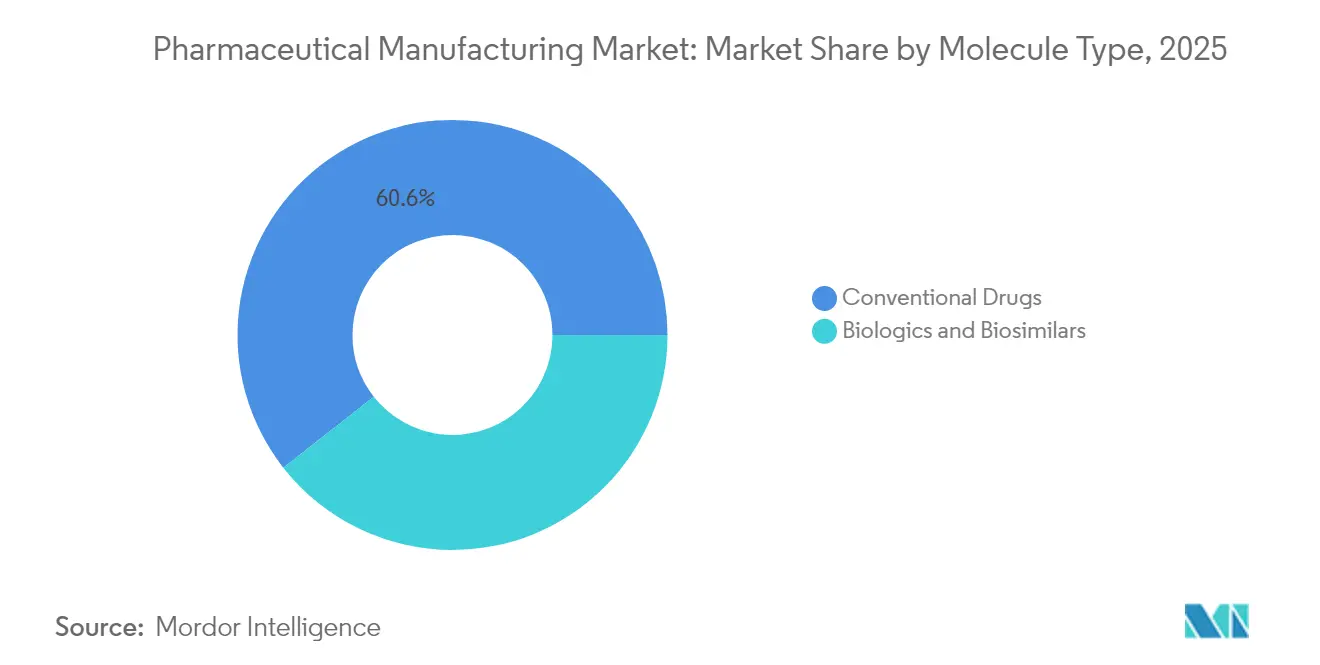
Note: Segment shares of all individual segments available upon report purchase
By Manufacturing Mode: CDMO Outsourcing Accelerates
In-house sites held 58.79% share in 2025, sustained by legacy capabilities and intellectual-property considerations. Yet CDMOs, growing at 10.69% CAGR, have become central for cell-and-gene therapy, mRNA platforms, and high-potency APIs. As biosimilars and advanced modalities multiply, sponsors are outsourcing analytical development, fill-finish, and packaging to partners that can flex capacity quickly.
Hybrid approaches combine core in-house lines for flagship assets with outsourced manufacturing for variable-demand products, allowing companies to limit fixed-cost exposure. This strategy positions the pharmaceutical manufacturing market for balanced growth while enabling CDMOs to innovate in modular plant design and digital integration.
By Formulation: Injectable Demand Surges
Tablets led with 33.05% share in 2025, reflecting patient preference for oral dosage forms. Injectables, however, are advancing at 10.93% CAGR, propelled by biologic formulations that require parenteral delivery and by device innovations that improve self-administration. Continuous tableting has reached commercialization, while sterile-fill facilities adopt isolators and robotics to cut contamination risk.
Manufacturers invest in high-speed pre-filled-syringe lines and auto-injector assembly cells, as demonstrated by Novo Nordisk’s USD 4.1 billion fill-finish expansion aimed at alleviating global shortages. Patient-centric packaging and cold-chain logistics remain critical differentiators in the pharmaceutical manufacturing market.
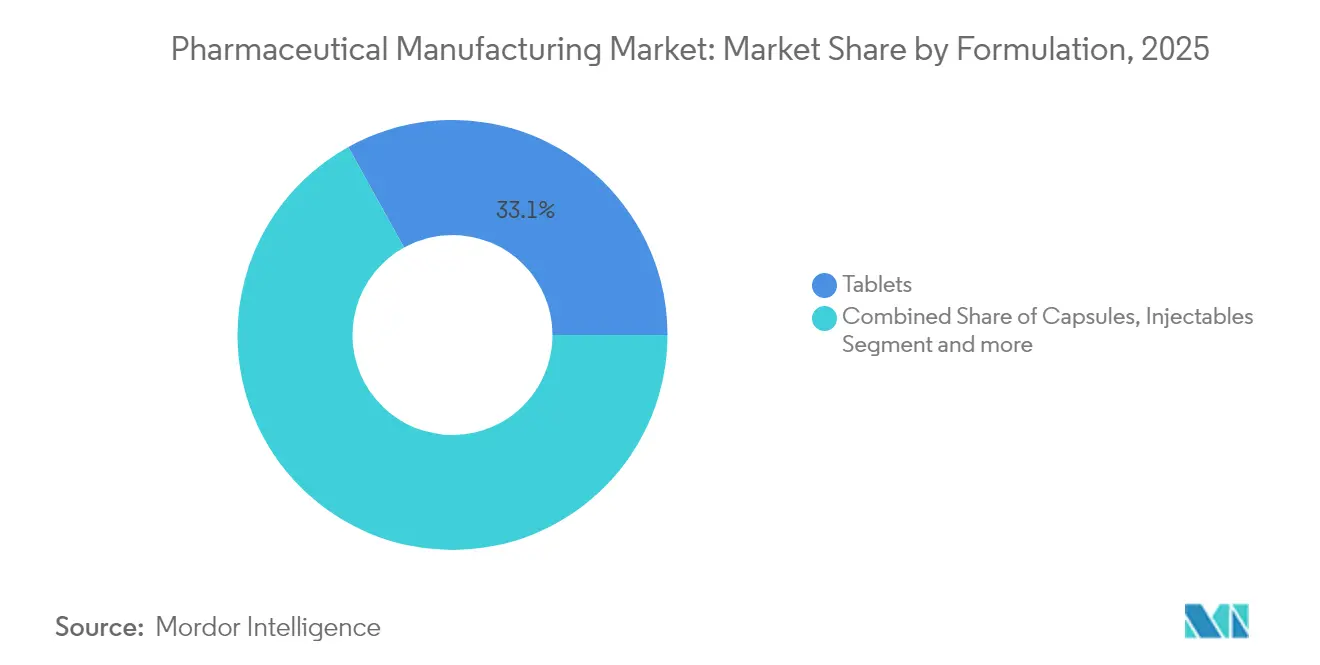
Note: Segment shares of all individual segments available upon report purchase
By Manufacturing Technology: Continuous Processing Gains Momentum
Batch processing still accounted for 74.05% of output in 2025, but continuous lines are growing at 12.05% CAGR, offering 24/7 operation and real-time release testing. Regulatory support such as the FDA’s Emerging Technology Program accelerates adoption, while digital twins fine-tune throughput and yield. The pharmaceutical manufacturing market tied to continuous platforms is projected to rise sharply as companies retrofit existing suites rather than build entirely new greenfield plants.
Single-use assemblies and modular skids further reduce changeover time, enabling multiproduct lines that serve orphan drugs and personalized therapies. Early adopters report 40% lower conversion costs, validating the business case for wider rollout.
By Application: Oncology Leads Growth
Oncology held 28.12% share of the pharmaceutical manufacturing market size in 2025, matching its position as the fastest-growing segment at 13.63% CAGR. CAR-T, radioligand, and antibody-drug-conjugate pipelines fuel capacity expansions in containment suites and aseptic processing. Sanofi’s EUR 300 (USD 351.4) million commitment to radioligand development exemplifies capital intensity.
Manufacturing requirements include highly specialized isolators, cryogenic logistics, and on-site quality labs to verify complex potency assays. Therapeutic areas such as diabetes and cardiovascular remain large but slower-growing, keeping multipurpose plants relevant across the pharmaceutical manufacturing market.
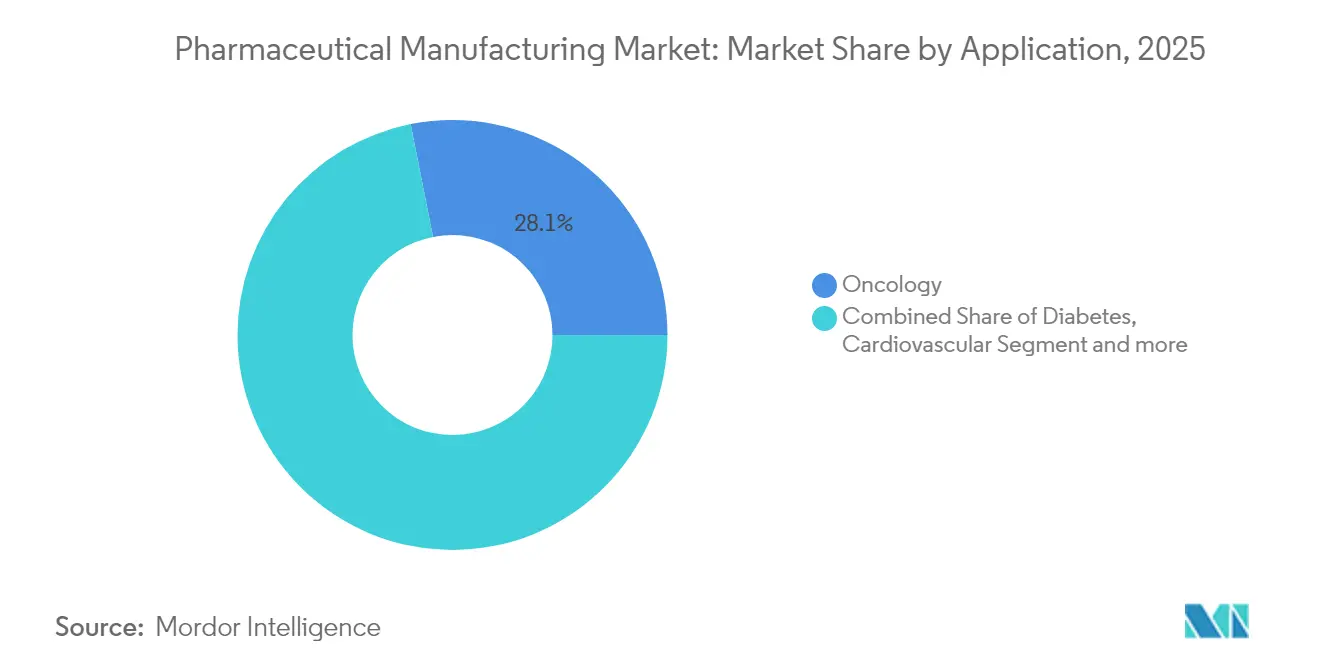
Note: Segment shares of all individual segments available upon report purchase
By Prescription Type: OTC Growth Accelerates
Prescription therapeutics dominated with 83.05% share in 2025, underpinned by stringent clinical and regulatory oversight. OTC medicines, growing at 11.67% CAGR, capitalize on consumer self-care and regulatory switches that move mature brands behind the counter. High-volume lines and blister packaging innovations bolster efficiency, whereas prescription products must comply with serialization mandates and stricter handling protocols.
Manufacturers are streamlining supply chains by co-locating OTC and prescription production in shared facilities equipped to meet divergent labelling, quality, and audit requirements, ensuring flexibility throughout the pharmaceutical manufacturing market.
Geography Analysis
North America retained 37.25% market share in 2025, anchored by more than USD 200 billion in announced capacity expansions from Roche, Eli Lilly, and Johnson & Johnson, each committing USD 50 billion-plus to U.S. projects. Executive Order 14293 streamlines domestic approvals, while continuous-processing pilots showcase innovation leadership. Canada and Mexico complement the regional network through pathway harmonization and cost-competitive API sites.
Europe maintains a strong position through established clusters in Germany, France, Italy, Spain, and the United Kingdom. The proposed Critical Medicines Act aims to improve supply security and sustainability standards, driving investments in green chemistry and circular-manufacturing pilots. EMA guidance on continuous and modular plants helps align national authorities and accelerates market entry for advanced therapies across the continent.
Asia-Pacific is the fastest-growing region at 12.4% CAGR to 2031, led by India’s expanding CRDMO ecosystem and China’s mRNA and monoclonal antibody capacity additions. Japan, South Korea, and Australia supply high-purity biologics, while Singapore and Vietnam attract fill-finish projects that benefit from skilled labor pools and pro-investment policies. Regulatory convergence initiatives and government subsidies for automation position the pharmaceutical manufacturing market for sustained regional momentum.

Competitive Landscape
The market exhibits moderate concentration. Technology adoption not sheer volume defines competitive positioning, as early movers in continuous processing and AI enjoy 150-200% productivity gains.
Patent expirations worth USD 236 billion intensify competition for biosimilar licenses, encouraging incumbents to diversify portfolios and invest in high-potency, small-batch suites that satisfy oncology demand. The FDA's draft Strategy Document on Innovative Manufacturing Technologies for fiscal years 2023-2027 provides regulatory support for advanced manufacturing adoption, creating competitive opportunities for companies that successfully navigate technology validation and implementation challenges.
Strategic moves include mergers to secure cell-therapy know-how, multibillion-dollar capacity announcements, and joint ventures that pool AI talent with manufacturing assets. Pharmerging competitors anchored in AI-first drug design partner with specialized CDMOs to leapfrog legacy infrastructure, adding dynamism to the pharmaceutical manufacturing market.
Pharmaceutical Manufacturing Industry Leaders
Pfizer Inc.
AstraZeneca
Sanofi
F. Hoffmann-La Roche Ltd
Eli Lilly and Company
- *Disclaimer: Major Players sorted in no particular order
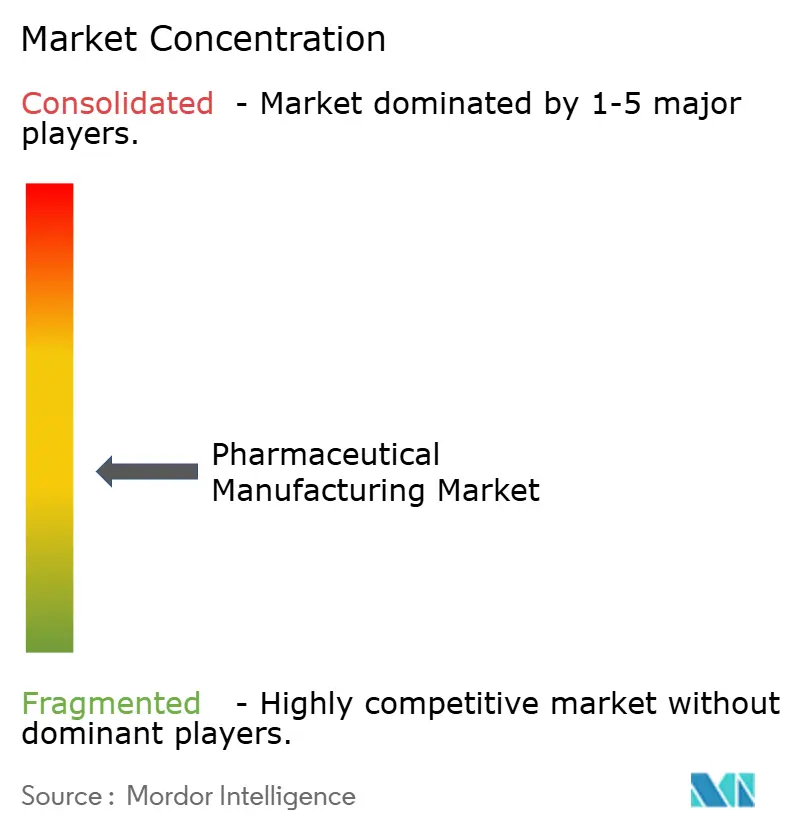
Recent Industry Developments
- May 2025: Genentech revealed plans to invest over USD 700 million in a new 700,000 square foot drug manufacturing facility in Holly Springs, North Carolina, creating over 400 manufacturing jobs and 1,500 construction positions to support metabolic medicines portfolio.
- May 2025: Gilead Sciences announced USD 32 billion investment in U.S. manufacturing and R&D through 2030, expected to generate USD 43 billion in economic value and create over 3,000 jobs by 2028.
- April 2025: Roche unveiled USD 50 billion investment in U.S. pharmaceuticals and diagnostics over 5 years, including new R&D facilities and manufacturing sites across 8 states, creating over 12,000 jobs.
- April 2025: Novartis announced USD 23 billion investment over 5 years to expand U.S. manufacturing and R&D presence, establishing 10 facilities including 7 new sites for APIs, biologics, and radioligand therapies.
- January 2024: Samsung Biologics presented its 2024 business strategy at a conference held in the United States. At the conference, the company showed its commitment to accelerate its efforts to manufacture high-quality biomedicines to meet the evolving global demand.
Global Pharmaceutical Manufacturing Market Report Scope
As per the report's scope, pharmaceutical manufacturing is the industrial-scale synthesis of pharmaceutical drugs as part of the pharmaceutical industry. Drug manufacturing can be broken down into unit operations, such as milling, granulation, coating, and tablet pressing.
The pharma manufacturing market is segmented by molecule type, drug development type, formulation, application, prescription type, and geography. By molecule type, the market is segmented into biologics and biosimilars (large molecules) and conventional drugs (small molecules). By drug development type, the market is segmented into outhouse and in-house. By formulation, the market is segmented into tablets, capsules, injectables, sprays, and other formulations. By application, the market is segmented into cancer, diabetes, cardiovascular diseases, neurological diseases, respiratory diseases, and other application types. By prescription type, the market is segmented into prescription medications and over-the-counter medications. The report also covers the market sizes and forecasts for major countries across different regions. For each segment, the market size is provided in terms of value (USD).
| Biologics & Biosimilars (Large Molecule) |
| Conventional Drugs (Small Molecule ) |
| In-house |
| CMO/CDMO |
| Tablets |
| Capsules |
| Injectables |
| Topical & Transdermal |
| Nasal & Pulmonary Sprays |
| Others |
| Batch |
| Continuous |
| Single-Use |
| Oncology |
| Diabetes |
| Cardiovascular |
| Neurology |
| Respiratory |
| Others |
| Prescription Drugs |
| Over-the-Counter (OTC) |
| North America | United States |
| Canada | |
| Mexico | |
| Europe | Germany |
| United Kingdom | |
| France | |
| Italy | |
| Spain | |
| Rest of Europe | |
| Asia-Pacific | China |
| Japan | |
| India | |
| Australia | |
| South Korea | |
| Rest of Asia-Pacific | |
| Middle East & Africa | GCC |
| South Africa | |
| Rest of Middle East & Africa | |
| South America | Brazil |
| Argentina | |
| Rest of South America |
| By Molecule Type | Biologics & Biosimilars (Large Molecule) | |
| Conventional Drugs (Small Molecule ) | ||
| By Manufacturing Mode | In-house | |
| CMO/CDMO | ||
| By Formulation | Tablets | |
| Capsules | ||
| Injectables | ||
| Topical & Transdermal | ||
| Nasal & Pulmonary Sprays | ||
| Others | ||
| By Manufacturing Technology | Batch | |
| Continuous | ||
| Single-Use | ||
| By Application | Oncology | |
| Diabetes | ||
| Cardiovascular | ||
| Neurology | ||
| Respiratory | ||
| Others | ||
| By Prescription Type | Prescription Drugs | |
| Over-the-Counter (OTC) | ||
| By Geography | North America | United States |
| Canada | ||
| Mexico | ||
| Europe | Germany | |
| United Kingdom | ||
| France | ||
| Italy | ||
| Spain | ||
| Rest of Europe | ||
| Asia-Pacific | China | |
| Japan | ||
| India | ||
| Australia | ||
| South Korea | ||
| Rest of Asia-Pacific | ||
| Middle East & Africa | GCC | |
| South Africa | ||
| Rest of Middle East & Africa | ||
| South America | Brazil | |
| Argentina | ||
| Rest of South America | ||
Key Questions Answered in the Report
What is the current size of the pharmaceutical manufacturing market
The pharmaceutical manufacturing market reached USD 555.4 billion in 2026 and is forecast to hit USD 885.21 billion by 2031.
Which segment is growing fastest in the pharmaceutical manufacturing market?
Continuous-processing technology is expanding at a 12.05% CAGR, while injectables and oncology therapeutics post the highest application-level growth at 10.93% and 13.63% respectively.
Why are CDMOs gaining share?
CDMOs grow at a 10.69% CAGR because sponsors outsource complex biologics, cell-therapy, and high-potency work to partners with specialized assets and regulatory expertise.
What role does continuous manufacturing play in cost reduction?
Continuous lines cut facility footprints by 70% and slash operating costs by up to 50%, while real-time analytics shorten release times and improve supply resilience.
Which region offers the highest growth potential through 2031?
Asia-Pacific shows the fastest regional CAGR at 12.4% as India, China, and Southeast Asian countries scale capacity and refine regulatory frameworks to attract global production mandates.
